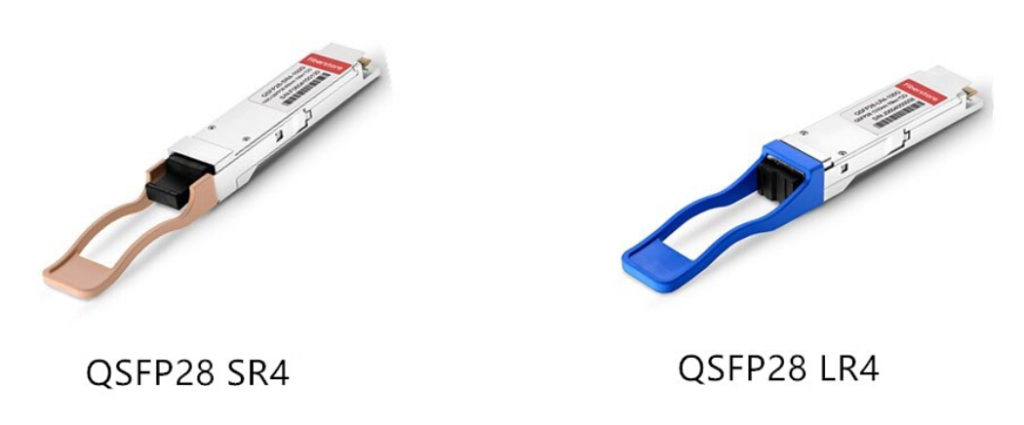- به وبلاگ خود خوش امدید
- Analysis of A Practical CWDM System Deployment Case
- Why Not Use EDFA Amplifier in Long CATV Network?
- Why Not Using DWDM Technology to Build Your Network?
- Optical Transponder—an Important Component in WDM System
- How to Build an Economical Long-haul 500Gbps Metro Network?
- Fiber Optical Communication
- Why Do We Need Optical Transponder (O-E-O)?
- CWDM Technology—Economically Saving Fibers for Your Network
- Confused About Loss in the Long Haul DWDM Network?
آخرین مطالب
امکانات وب
Since data centers have been experiencing an great infrastructure change to achieve higher levels of performance and scalability, the demand for 100G Ethernet network increases day by day. To better accommodate this great change, there are several kinds of transceivers designed for deploying 100G Ethernet network, such as, CFP, CFP2, CFP4, QSFP28, CPAK, etc. Among these 100G optics, QSFP28 transceiver offers the optimal solution for the 100G migration with the lowest power consumption which is very commonly used at present. In this paper, it will introduce QSFP28 transceiver and analyze the reason why QSFP28 transceiver is so popular in 100G Ethernet network.
As the smallest 100G form factor transceiver, QSFP28 transceiver has the same size and lane number as 40G QSFP+ transceiver, which is implemented with four 25-Gbps lanes to achieve 100G transmission. With the design of an upgraded electrical interface, it is able to support signals rates up to 28 Gbit/s that makes the deployment of 100G Ethernet network as easy as that of 10G Ethernet networks.
Generally, there are two types of QSFP28 transceivers, QSFP28 SR4 and QSFP28 LR4, which are used for different applications. As for QSFP28 SR4, it is suitable for 100G short distance transmission through multimode fiber up to 100 m. As for QSFP28 LR4, it is widely applied in 100G long distance transmission through single mode fiber, at lengths up to 10 km. The following figure shows the two types of QSFP28 transceivers for your reference.

There is no doubt that QSFP28 transceiver has a lot of advantages that make itself more popular than other 100G optics. In order to better deploy 100G Ethernet network, QSFP28 transceiver is designed with a strong improvement that increases port density and decreases power consumption with a lower cost, which will be illustrated detailedly in the following text.
Higher Port Density: As we know, the first generation of 100G transceiver is CFP, which is designed with a very large form factor. As for the next generations, CFP2 and CFP4, although their sizes decrease a lot, they are still larger than 40G QSFP+ transceiver. However, QSFP28 is published soon as the smallest 100G form factor transceiver with the same footprint and face plate density as QSFP+ transceiver. In general, with its advantage of high port density, we can install up to 36 QSFP28 on a 1RU switch on the front panel.
Lower Power Consumption: As for the general 100G optics, their power consumption ranges from 6 W to 24 W. In the contrast with these optics, QSFP28 transceiver transmits signals with the lowest power, less than 3.5 W. In short, QSFP28 transceiver is the most ideal solution for 100G transmission with the lowest power consumption at present.
Lower Cost: The deployment of 100G Ethernet network with QSFP28 transceiver can save a lot which mainly shows in the following aspects. Firstly, it can save considerable amount of money with the advantages of higher port density and lower power consumption. Secondly, it is implemented with four lanes, increasing the transmission capacity of every lane from 10G to 25G, thus it effectively decreases cost for each bit. Thirdly, both of its electrical and optical lanes work at the same speed that eliminates the costly gearbox found in CFP, CFP2 and CPAK. Finally, its way of migrating to 100G Ethernet network is also superior that can change from 10G-40G-100G to 10G-25G-100G or 10G-25G-50G-100G, much simplifying the cabling and saving the cost in data centers.
In short, QSFP28 transceiver will be more and more commonly used, ensuring data centers to scale 100G networks with the same simplicity as 10G networks. After knowing the advantages of QSFP28 transceiver, do you also want to achieve higher levels of performance and scalability by using QSFP28 transceiver for your system? If you only need a 100G short distance connection, you can choose QSFP28 SR4. And QSFP28 LR4 would be a good choice for 100G long distance transmission.
Fiber Optical Communication...برچسب : نویسنده : afiberopticalcom1 بازدید : 49
لینک دوستان
- کرم سفید کننده وا
- دانلود آهنگ جدید
- خرید گوشی
- فرش کاشان
- بازار اجتماعی رایج
- خرید لایسنس نود 32
- هاست ایمیل
- خرید بانه
- خرید بک لینک
- کلاه کاسکت
- موزیک باران
- دانلود آهنگ جدید
- ازن ژنراتور
- نمایندگی شیائومی مشهد
- مشاوره حقوقی تلفنی با وکیل
- کرم سفید کننده واژن
- اگهی استخدام کارپ
- دانلود فیلم
- آرشیو مطالب
- فرش مسجد
- دعا
- لیزر موهای زائد
- رنگ مو
- شارژ
